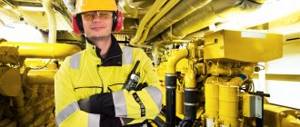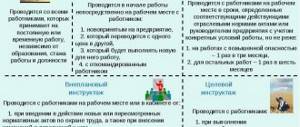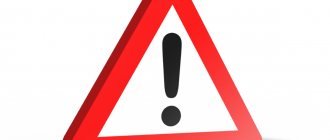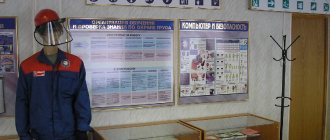| [organizational and legal form, name of organization, enterprise] | I approve [position, signature, full name of the manager or other official authorized to approve the job description] [day month Year] M.P. |
Job description of the head of the labor protection department [name of organization, enterprise, etc.]
This job description has been developed and approved in accordance with the provisions of the Labor Code of the Russian Federation and other regulations governing labor relations in the Russian Federation.
I. General provisions
1.1. The head of the labor protection department belongs to the category of managers.
1.2. A person with a higher professional (technical) education and work experience in labor protection in engineering, technical and managerial positions of at least [value] years is appointed to the position of head of the labor protection department.
1.3. Appointment to the position of head of the labor protection department and dismissal from it are made by order of the director of the enterprise.
1.4. The head of the labor safety department reports directly to [fill in as appropriate].
1.5. During the absence of the head of the labor protection department (illness, vacation, business trip, etc.), his official duties are performed by a deputy (and in the absence of a deputy, by a person appointed by order of the director of the enterprise), who bears full responsibility for their high-quality, efficient and timely implementation.
1.6. In his activities, the head of the labor protection department is guided by:
— legislative and regulatory acts on labor protection issues;
— methodological materials on labor protection;
— the charter of the enterprise;
— labor regulations of the enterprise, orders and instructions of the director of the enterprise;
- this job description.
1.7. The head of the labor protection department must know:
— legislative and regulatory legal acts, methodological materials on labor protection issues;
— production and organizational structure of the enterprise;
— equipment of the enterprise and principles of its operation;
— basic technological processes;
— methods for studying working conditions in the workplace;
— organization of work on labor protection;
— psychophysiological requirements for workers, taking into account the category of severity of work, restrictions on the use of labor by women, adolescents, and workers transferred to light work;
— rules and means of monitoring compliance of the technical condition of equipment with the requirements for safe work;
— the procedure for conducting accident investigations at the enterprise;
— advanced domestic and foreign experience in the field of labor protection;
— methods and forms of propaganda and information on labor protection materials;
— the procedure and timing of reporting on the implementation of labor protection measures;
— labor legislation of the Russian Federation;
— internal labor regulations.
What a specialist should know
The work of the head of the security service is regulated by a number of documents that he must know. In his professional activities, this specialist must be guided by the requirements of legislation, methodological materials, the charter of the enterprise, internal regulations, job descriptions, as well as orders of immediate superiors.
The responsibilities of the head of the security service include knowledge of first aid methods, the rules of hand-to-hand combat, and the ability to use firearms and knives. The head of the security service must know the characteristics of the protected object, methods of its protection, rules of operation, storage and transportation of material assets. If necessary, he must be able to use various means of communication.
II. Functions
The head of the labor protection department is assigned the following functions:
2.1. Organization and coordination of labor protection work at the enterprise.
2.2. Interaction with third parties in the performance of their duties.
2.3. Monitoring compliance in the structural divisions of the enterprise with legislative and regulatory legal acts on labor protection.
2.4. Participation in the coordination of project documentation developed at the enterprise in order to comply with labor safety requirements.
2.5. Methodological assistance to heads of enterprise departments on labor protection issues.
2.6. Providing training on labor protection for enterprise employees.
2.7. Organization of knowledge dissemination on labor protection issues at the enterprise.
Which organizations need a health and safety specialist?
As soon as an organization’s staff grows to 50 people (or, to be more precise, it “exceeds” the number 50), then, according to the Labor Code of the Russian Federation, its staff must have its own specialist. This is stated in Article 217 of the Labor Code of the Russian Federation. However, this same article does not prohibit the creation of such a staff unit with a smaller staff. For small organizations, this remains at the discretion of the employer.
Do you believe that you can spend no more than 2 hours a week on labor protection? Of course, without loss of quality of work.
III. Job responsibilities
Head of Labor Safety Department:
3.1. Organizes and coordinates work on labor protection at the enterprise, monitors compliance in structural units with legislative and regulatory legal acts on labor protection, carries out preventive work to prevent industrial injuries, occupational and work-related diseases, measures to create healthy and safe working conditions at enterprise, for providing employees with established benefits and compensation for working conditions.
3.2. Organizes the study of working conditions at workplaces, measures the parameters of dangerous and harmful production factors, certification and certification of workplaces and production equipment for compliance with labor protection requirements, monitors the timeliness of planned activities.
3.3. Participates in the investigation of accidents at the enterprise and the development of measures to prevent them.
In the event of an accident at work, takes immediate measures to prevent the development of an emergency situation and the impact of traumatic factors on other persons.
3.4. Informs employees on behalf of the employer about the state of working conditions in the workplace, as well as about measures taken to protect against dangerous and harmful production factors, ensures the preparation of documents for the payment of compensation for harm caused to the health of employees as a result of an industrial accident or occupational disease.
3.5. Organizes inspections and surveys of the technical condition of buildings, structures, equipment, machines and mechanisms for compliance with the requirements of regulatory legal acts on labor protection, checks of the efficiency of ventilation systems, the condition of sanitary facilities, collective and individual protective equipment for workers. Monitors the timeliness of these checks.
3.6. Ensures the participation of department employees in the preparation and submission of proposals for the development and implementation of more advanced designs of fencing equipment, safety and locking devices, and other means of protection from the effects of hazardous and harmful production factors, the development and implementation of measures to create safe and healthy working conditions, rational working conditions and rest.
3.7. Participates in the drafting of the “Occupational Safety and Health” section of the collective agreement, monitors its implementation, as well as compliance with the instructions of state supervision and control bodies, and other measures to improve working conditions.
3.8. Participates in the coordination of design documentation developed at the enterprise, in the work of commissions for the acceptance into operation of completed construction or reconstructed production facilities, for the acceptance of installations, units and other equipment from repair in terms of compliance with the requirements of regulatory legal acts on labor protection.
3.9. Provides methodological assistance to heads of enterprise departments in compiling lists of professions and positions, according to which employees must undergo mandatory preliminary and periodic medical examinations, as well as lists of professions and positions, according to which, on the basis of current legislation, workers are provided with compensation and benefits for severe, harmful or dangerous working conditions, when developing and revising labor protection instructions, enterprise standards for labor safety.
3.10. Provides introductory and repeated briefings, training and testing of knowledge on labor protection of enterprise employees.
3.11. Monitors the correctness of spending funds on labor protection measures in the divisions of the enterprise, analyzes and summarizes proposals for their expenditure and prepares justifications for the allocation of funds to the enterprise from the territorial labor protection fund for measures to improve working conditions and safety.
3.12. Organizes the work of the labor protection office, propaganda and information on labor protection issues at the enterprise using for these purposes the internal radio network, television, wall newspapers, shop windows, providing the enterprise departments with rules, regulations, instructions, posters and other visual aids on labor protection, and also providing them with methodological assistance in equipping appropriate information stands.
3.13. Brings to the attention of the enterprise's employees the new legislative and regulatory legal acts on labor protection that are being introduced, organizes the storage of documentation on labor protection, the preparation of reports in established forms and in accordance with the deadlines established by regulatory legal acts on labor protection.
3.14. Participates in the consideration of letters, applications and complaints from employees on labor protection issues and the preparation of proposals on them to the employer to eliminate existing shortcomings and omissions identified during investigations, as well as preparing responses to applicants.
3.15. Communicates with medical institutions, research and other organizations on occupational safety issues and takes measures to implement their recommendations.
3.16. Manages department employees.
3.17. [Enter as appropriate].
Roles, tasks and responsibilities
The responsibilities of a security chief cover a wide range of activities. These include the following:
- protection of the organization’s property from criminal actions of other persons, natural disasters, fires, accidents and other force majeure circumstances;
- carrying out security measures;
- development and implementation of security methods and means of protection;
- repelling threats and attacks, eliminating their negative consequences;
- checking the condition of technical safety equipment;
- checking the loyalty of staff and visitors;
- ensuring uninterrupted communication with the security and safety authorities of the entrusted facility;
- troubleshooting and troubleshooting of technical means of protection;
- assistance to internal affairs bodies in solving crimes in the entrusted territory.
IV. Rights
The head of the labor protection department has the right to:
4.1. Get acquainted with draft decisions of the enterprise management concerning the activities of the labor protection department.
4.2. Interact with the heads of all (individual) structural divisions of the enterprise.
4.3. Provide heads of departments of the enterprise and specialists with mandatory instructions on labor protection issues.
4.4. Invite specialists and employees of structural divisions of the enterprise and other organizations to participate in meetings on occupational safety issues.
4.5. Sign and endorse documents within your competence.
4.6. Make, in the prescribed manner, proposals to reward distinguished employees and impose penalties on violators of production and labor discipline.
4.7. Require the management of the enterprise to provide assistance in the performance of official duties.
4.8. [Enter as appropriate].
Administrative responsibility
Unlike disciplinary, administrative liability can be brought against an organization and an official who was obliged to demand compliance with the requirements of employee labor protection, but did not do so, or did not do so completely.
The GIT inspector is held accountable within the limits of his powers. This means that the inspector has the right to impose a fine, suspend the company’s activities, and also issue a warning to the official. The inspector has no right to apply disqualification. The court can do this.
Reference. Many employers and occupational safety specialists confuse two concepts—prescription and regulation.
An order is a decision of the GIT inspector, which he issues immediately after the inspection. In the order, the inspector does not indicate the amount of the fine, but prescribes what actions the employer must take and within what time frame. For example, conduct a special medical examination before December 1, 2021, conduct a medical examination before October 1, 2021, or suspend activities for 90 days - immediately. The district court at the location of the GIT inspector can challenge the order.
A resolution is a document that an inspector issues following the consideration of a case of an administrative offense. The resolution must already indicate what specific fine to impose on officials, as well as on the organization.
An example of the wording of a resolution
“To hold Torpedo LLC accountable under Part 2 of Article 5.27.1 of the Code of Administrative Offenses of the Russian Federation for violating the procedure for carrying out SOUT in the form of a fine in the amount of 50,000 rubles, and also to establish a fine for officials in the amount of 10,000 rubles for General Director Ilyin I.V. , and in the amount of 5,000 for occupational safety specialist Muzyka V.A.”
A complaint against the inspector's decision is filed with a higher body of the State Tax Inspectorate, a higher official of the State Inspectorate, or the district court at the place where the case was heard, that is, the district court at the place where the offense was committed. Such a place is the address of the employer (clause 3, part 1, article 30.1 of the Code of Administrative Offenses of the Russian Federation).
Decisions of state labor inspectors can be appealed both in court and in the order of subordination, with the exception of decisions of the chief state labor inspector of the Russian Federation, which can be appealed exclusively in court. At the same time, Art. 361 of the Labor Code of the Russian Federation allows an appeal against the decision of the state labor inspector in the order of subordination directly to the chief state labor inspector of the Russian Federation - the head of Rostrud.
To quickly understand how administrative fines are set, we have compiled a table with examples
| Article 5.27.1 | Base | Application example |
| Part 1 | They are brought to justice for violations of the requirements of legal regulations in the field of occupational safety, registered with the Ministry of Justice of Russia. | If an employee is not given personal protective equipment that must be declared, the legal entity will be fined from 50,000 to 80,000 rubles |
| Part 2 | Violation of the procedure for conducting SOUT | If you create a commission to conduct a special assessment in violation, the fine for officials can range from 5,000 to 10,000 rubles. A legal entity will be fined from 60,000 to 80,000 rubles |
| Part 3 | Admission of employees without occupational safety training or without medical examinations and (or) psychiatric examination | If the company has not carried out a preliminary, pre-shift or periodic medical examination, the fine for officials can range from 15,000 to 25,000 rubles, and for legal entities - from 110,000 to 130,000 rubles |
| Part 4 | Lack of PPE for workers | If the employee was not given class 2 PPE, and this is personal protective equipment subject to certification, then the fine may be 130,000 - 150,000 rubles, and for responsible persons from 20,000 to 30,000 rubles |
| Part 5 | Repeated violation of occupational safety requirements | If during the calendar year the organization, as well as the official, have already been held accountable for similar violations, the fine for authorized persons may range from 30,000 to 40,000 rubles, or disqualification may be applied. In this case, the organization will be fined up to 200,000 rubles, or its activities will be suspended for up to 90 days. |
Let's take a closer look at what disqualification is. This is a type of administrative punishment. It is determined by the court. An individual may, by a court decision, be deprived of the right to hold the position of a manager, as well as an official who performs organizational, administrative or administrative functions. The court sets the period of disqualification depending on the severity of the charge and whether the disqualified person has similar offenses in the past. It can range from 6 months to 3 years.











